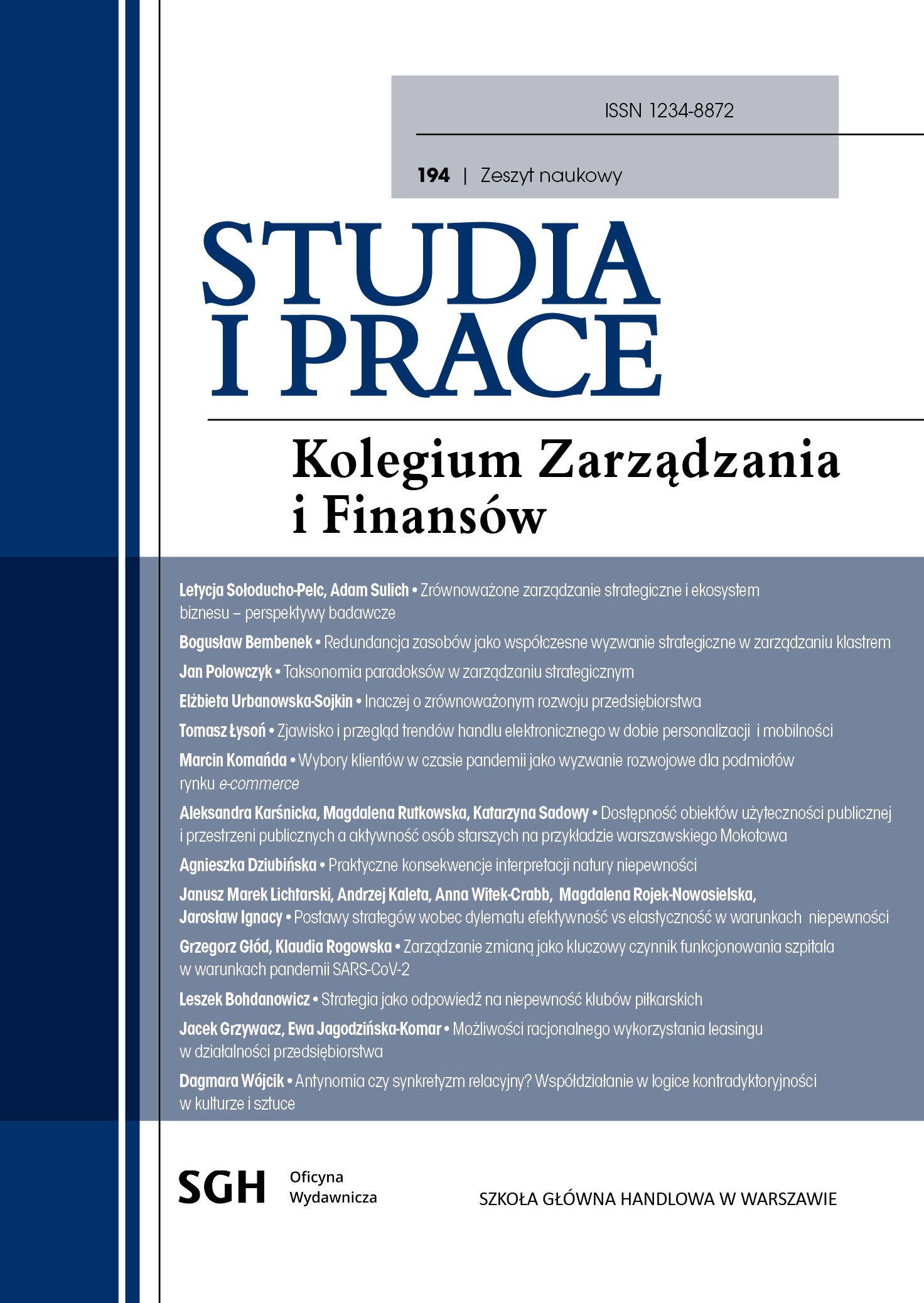Strategia jako odpowiedź na niepewność klubów piłkarskich
DOI:
https://doi.org/10.33119/SIP.2023.194.11Słowa kluczowe:
klub piłkarski, niepewność, zarządzanie strategiczneAbstrakt
Kluby piłkarskie, tak jak inne organizacje, podlegają rosnącej niepewności otoczenia. Wynika ona z niestabilności makrootoczenia oraz zmian, jakie zachodzą w ich otoczeniu konkurencyjnym. Coraz częściej właściciele i menedżerowie tych klubów starają się budować odporne organizacje, wdrażając różne elementy procesu zarządzania strategicznego na wzór podmiotów działających w innych branżach. Niniejszy artykuł ma charakter koncepcyjny, a jego celem jest przedstawienie modelu procesu zarządzania strategicznego klubem piłkarskim oraz modelu strategii pionu sportowego. Opisano w nim podstawowe zmiany zachodzące w otoczeniu klubów piłkarskich i sposób, w jaki mogą one na nie odpowiedzieć.
Downloads
Bibliografia
Wydawnictwa zwarte
Bohdanowicz, L. (2022). Praktyka zarządzania klubem piłkarskim. Strategia – struktura – tożsamość. Warszawa: CeDeWu.
Czakon, W. (2020). Krótkowzroczność strategiczna menedżerów. Kraków: Wydawnictwo Uniwersytetu Jagiellońskiego.
Davidsen, M., Hammer, D. (2021). How Hard It Can Be? Strategies in Football: On and off the Pitch. Dragør: Zuma.
Draebye, M. (2020). Strategic Management in Football Organisations. W: Routledge Handbook of Football Business and Management (s. 171–185), S. Chadwick, D. Parnell, P. Widdop, Ch. Anagnostopoulos (Eds.). New York: Routledge.
Artykuły naukowe
Antonioni, P., Cubbin, J. (2000). The Bosman Ruling and the Emergence of a Single Market in Soccer Talent, European Journal of Law and Economics, 9 (2), s. 157–173.
Bauers, S., Lammert, J., Faix, A., Hovemann, G. (2020). Club Members in German Professional Football and Their Attitude towards the ‘50+1 Rule’. A Stakeholder-Oriented Analysis, Soccer and Society, 21 (3), s. 274–288.
Chadwick, S., Clowes, J. (1998). The Use of Extension Strategies by Clubs in the English Football Premier Leagues, Managing Leisure, 3, s. 194–203.
Cyfert, S., Janicki, M. (2014). Zastosowanie koncepcji modelu biznesu do opisu logiki funkcjonowania klubu piłkarskiego, Marketing i Rynek, 5, s. 287–294.
Fernandez-Navarro, J., Fradua, L., Zubillaga, A., Ford, P., McRobert, A. (2016). Attacking and Defensive Styles of Play in Cocker: Analysis of Spanish and English Elite Teams, Journal of Sport Science, 34 (24), s. 2195–2204.
Hamil, S., Walters, G. (2010). Financial Performance in English Professional Football: ‘An Inconvenient Truth’, Soccer and Society, 11 (4), s. 354–372.
Hewitt, A., Greenham, G., Norton, K. (2016). Game Style in Soccer: What Is It and Can We Quantify It?, International Journal of Performance Analysis in Sport, 16 (1), s. 355–372.
Kornai, J., Maskin, E., Roland, G. (2003). Understanding the Soft Budget Constraint, Journal of Economic Literature, 41, s. 1095–1136.
Ludvigsen, J. (2019). Foreign Ownership’ in the Premier League: Examining Local Liverpool Fans’ Perception of Fenway Sports Group, Soccer and Society, 20 (4), s. 602–625.
Ocasio, W., Kraatz, M., Chandler, D. (2023). Making Sense of Corporate Purpose, Strategy Science, 8 (2), s. 123–138.
Rohde, M., Breuer, Ch. (2017). The Market for Football Club Investor: A Review of Theory and Empirical Evidence from Professional European Football, European Sport Management Quarterly, 17 (3), s. 265–289.
Storm, R. (2009). The Rational Emotions of FC København: A Lesson on Generating Profit in Professional Soccer, Soccer and Society, 10 (3–4), s. 459–476.
Storm, R., Nielsen, K. (2012). Soft Budget Constraints in Professional Football, European Sport Management Quarterly, 12 (2), s. 183–201.
Pobrania
Opublikowane
Jak cytować
Numer
Dział
Licencja
Prawa autorskie (c) 2024 Studia i Prace Kolegium Zarządzania i Finansów

Utwór dostępny jest na licencji Creative Commons Uznanie autorstwa 4.0 Międzynarodowe.









